Reviews
Larry Clark Still Loves Looking at Naked Kids, in Luhring Augustine Show
Let’s call the whole thing what it plainly is: Old Man Teenage Lusting.
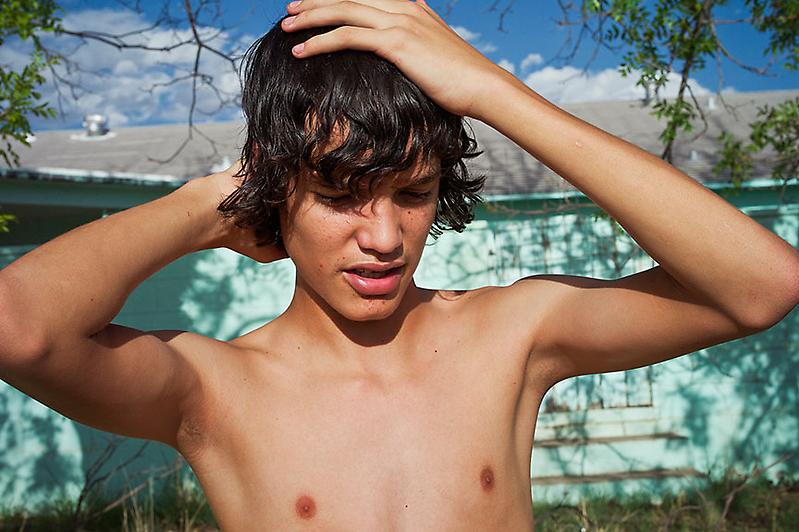
Let’s call the whole thing what it plainly is: Old Man Teenage Lusting.

Christian Viveros-Fauné

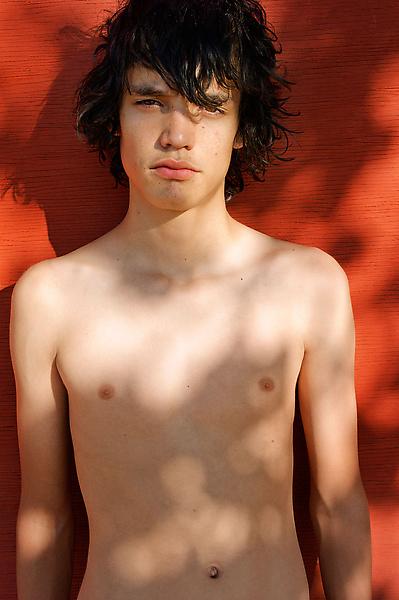
Larry Clark, Adam, Marfa, TX (2011)
© Larry Clark; Courtesy the artist and Luhring Augustine, New York.
Not a lot of people showed up for Larry Clark’s gallery walk-through at Luhring Augustine’s West 24th Street space last Friday. Not even the 71 year-old artist, due to an unspecified hand ailment. This left your correspondent plenty of time to 1) chat with the only other art writer present; 2) field an unexpected long-distance phone call; and 3) generally have some alone time with the photographs, collages, paintings, and single mixed-media assemblage by the photographer, film director and writer Larry Clark. The experience was like being put in a room with some creepy uncle’s capsized box of teener porn.
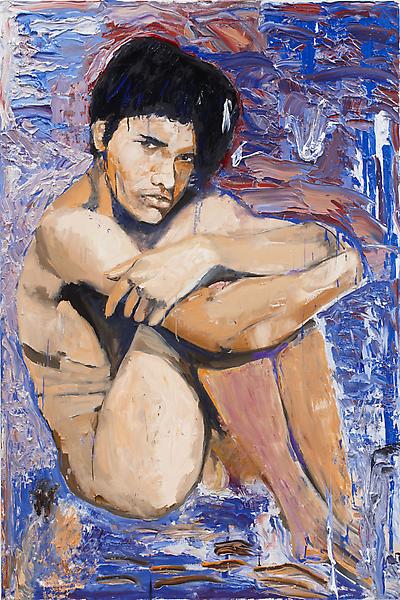
Larry Clark, Jonathan (5), (2014),
© Larry Clark; Courtesy the artist and Luhring Augustine, New York.
The influential creator of an endlessly copied look of underage anomie, Clark made pictures that first captured America’s vast teenage wasteland of self-destruction in 1971 with Tulsa, an unforgettable book of photographs that arrived, it seemed, from deviant outer space. Black and white photos of the artist and his young friends shooting amphetamines, fucking and engaging in gunplay, the images tore the curtain off America’s sleazy kiddie heartland—a seedy concatenation of country-fried flophouses and dingy basements that was as far from Mayberry as it was from Times Square. A long-awaited follow-up, Teenage Lust, appeared in 1983. It upped the quotient of sex and drugs, while including portraits of young urban male hustlers, as well as the universal visual appeal of young tumescent flesh wilting, nearly imperceptibly, on the vine.
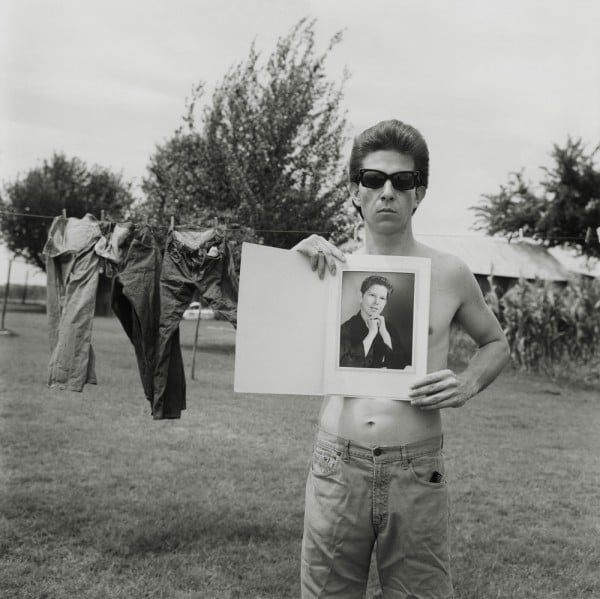
Larry Clark, Billy Mann (1961)
© Larry Clark, courtesy of the artist and Luhring Augustine, New York.
After Clark directed a Chris Isaak music video a decade later, he turned to film and the 1995 movie Kids, which served as a kind of apotheosis of Clark’s massively influential “participative” aesthetic. The film featured graphic everything plus a twisted storyline: It followed a day-in-the-life of an HIV-positive lothario and his NYC skate-rat friends. Its documentary feel and matching “objective” P.O.V. created a small sensation, while propagating the falsehood that Clark’s plot and subjects were somehow real. A corner had been turned. What was once real-life documentation became fashion and entertainment. The casual rawness of the photographer’s earlier images quickly turned into prototypes for other films (Clark’s directing credits include Bully, Whassup Rockers, and the unreleased Ken Park) and, eventually, a corporate look adopted by American Apparel and Vice Media. It’s impossible to take in Clark’s latest exhibition of new and old work without considering the effects of this popular conversion. At Luhring Augustine, for instance, the artist inhabits a CVS Pharmacy’s worth of over-the-counter ideas that literally are clichés of his own devising.
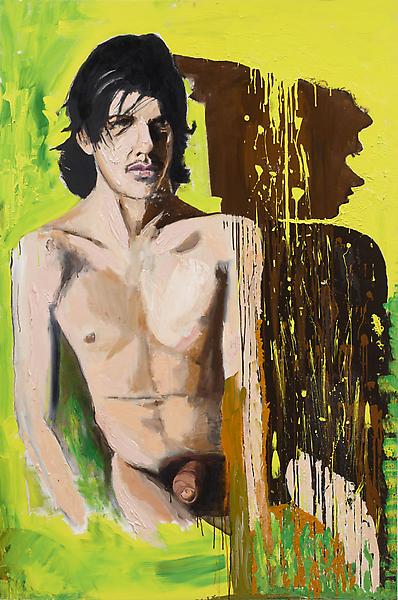
Larry Clark, Jonathan (1), (2014)
© Larry Clark; Courtesy of the artist and Luhring Augustine, New York.
The photographer’s new Chelsea show—titled with first-person emphasis “they thought i were but i aren’t anymore”—has been organized like something of a mini-survey. It features the B-sides of a few old hits in the form of two undistinguished early black and white snaps of Clark’s original Tulsa friends; a trio of 2011 photographs of a characteristically Caravaggesque youth named Adam; seven recent photo and mixed media collages on the subjects of youth, drugs and sex (what else?); a “sculpture” made up of a collection of empty Oxycontin vials and dope buds inside a wooden box (with a napkin note that reads, I kid you not, “This will end badly”); as well as the first paintings the artist has ever shown in public. About the latter, suffice it to say that—bar the self-portrait of the artist wearing a crown of thorns—they’re the kind of competently impastoed homoerotic portraits one might find at a gay dive in The Village. Lust for Life this is not. Instead, let’s call the whole thing what it plainly is: Old Man Teenage Lusting.
Clark’s show is so preposterously hokey it’s hard to know where to begin to deflate its absurd pretenses at transgression. A good place to start is the three photocollages that serve as homages to the late actor, Brad Renfro—the former child actor and Bully star who died in 2008 from a heroin overdose. While one mixes a postcard of Botticelli’s Portrait of a Youth with photos of hetero kids having sex and clippings of the actor’s arrest and obituary, the other two “homages” feature multiple images Clark took of Renfro shooting up in his underwear—which the photographer then spattered a la syringe with his own blood. More subtly exploitative and predatory are Clark’s portraits of the adolescent Adam, a concave-chested boy with eyes as vulnerable as his build. The photographer’s relentless focus on the youth’s ruby lips and licorice hair are not merely disturbing; they actively shift the power equation between the artist and his subject noxiously in Clark’s direction. It’s hard to look at these photos and not wonder where the boy’s parents are.
Like Hemingway’s conflicted noble hero, Clark’s randy outlaw character is not just tired presently—he’s vapid, hackneyed and ridiculous. Rimbaud with an AARP card, Clark has become a living anachronism in an age when there is nothing more conservative and commercially cooptable than youth culture. Clark’s early photographs virtually invented teenage subcultures. This latest batch of work looks like memorabilia secreted from his own private Neverland Ranch. Few exhibitions in recent memory prove as shallow or depressing.
“they thought i were but i aren’t anymore…” runs through August 1 at Lurhing Augustine, 531 West 24th Street.